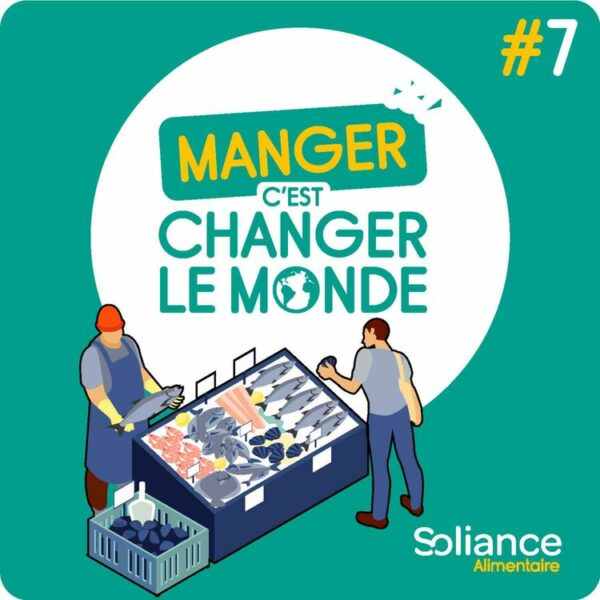Manger, c’est changer le monde, la série de podcasts qui décode les systèmes alimentaires – Épisode 7
Ce mois-ci, nous nous penchons sur les éclairages de Sylvain Kockmann, consultant Soliance Alimentaire spécialiste des équipements marchands, au sujet des Marchés d’Intérêts Nationaux. Au travers de son expertise, nous essayerons de comprendre les enjeux de ces marchés aux statuts si particuliers. Nous expliquerons d’abord ce que sont les MIN et comment ils fonctionnent, nous détaillerons les acteurs qui y prennent part, puis les enjeux qui y sont liés, que ce soit en France ou à l’international.
À quoi servent les MIN et pourquoi ont-ils été créés ? L’exemple du marché de Rungis
Les marchés d’intérêts généraux, ou MIN, sont ce qu’on appelle des marchés de gros : ils sont réservés aux professionnels, c’est pourquoi l’accès en est contrôlé.
Créés dans les années 60, ils sont “d’intérêt National” parce que la concurrence qu’ils obligent en regroupant les grossistes en un même lieu (par la loi) empêche la spéculation et maintient les prix au plus juste de la rencontre offre/demande par la circulation transparente de l’infirmation prix. On se rend compte de leur importance quand on travaille dans des pays en développement qui en sont dépourvus : les intermédiaires y sont tout-puissants, ce qui est loin d’être le cas chez nous, contrairement aux croyances. Par ailleurs, leur infrastructure contribue à la sécurisation de l’approvisionnement alimentaire des villes par la mutualisation d’investissements pour la normalisation, la conservation (froid) et la performance logistique.
Il en existe une trentaine en France et on peut en distinguer deux types selon leur emplacement macro géographique : d’une part les marchés d’expédition situés au coeur des zones de production agricole (il servent à rassembler les productions pour être expédiées partout en France et à l’export); d’autre part les marchés de consommation, situés historiquement au coeur des grandes villes. Ces derniers visent à approvisionner le tissu de commerces de proximité (tout ce qui est détaillants, mais aussi les restaurateurs et plus globalement l’ensemble des acteurs de la distribution et des filières alimentaires). A noter que les GMS ont leur propre logistique et ce circuit pesant environ 80% de la consommation les MIN ont donc perdu de leur poids dans la consommation globale.
Le MIN le plus connu est le marché de Rungis au sud de Paris, permettant d’approvisionner toute l’agglomération francilienne. Symbole de son importance, plus de 12 000 personnes y travaillent chaque jour, pour un chiffre d’affaires supérieur à 10 milliards d’euros.
Quels sont les différents acteurs présents sur les MIN, sites hautement stratégiques ?
Les MIN accueillent une grande diversité d’opérateurs et d’entreprises sur place, car ils sont le lieu de rencontre entre les producteurs, les transporteurs, les grossistes et les acheteurs. Ce sont des pôles économiques très importants pour les collectivités. Par exemple, l’équipe de Soliance avait travaillé il y a quelques années sur le marché de gros de Montpellier : le MIN constituait le premier bassin d’emploi, hors fonction publique, pour la métropole.
Ce sont des infrastructures qui ont un poids économique très important en termes d’emploi. Cela se traduit notamment par le tissu d’opérateurs qui se retrouvent sur ces marchés de gros avec une grande diversité de d’acteurs économiques.
Est-ce que certains MIN sont plus ou moins spécialisés selon les régions ?
Le visage des marchés d’expédition est bien sûr lié au paysage agricole dans lequel il s’insère, ainsi qu’à la nature des flux d’importations. Par exemple, celui de Perpignan est le reflet de la production de fruits et légumes du sud de la France, de l’Espagne et du Maroc. On observe néanmoins un certain nombre de marchés qui ont réussi à diversifier leur activité sur d’autres filières, comme la marée, les filières viandes ou les produits laitiers par exemple. Ils arrivent à proposer sur leur marché une diversité de gammes de produits assez riche et qui contribue donc à leur attractivité.
Quels sont les nouveaux enjeux pour les marchés de gros ?
L’équipe de Soliance Alimentaire intervient sur les marchés de gros en France et à l’international : les enjeux ne sont bien sûr pas les mêmes.
a. Les nouveaux enjeux pour les marchés de gros en France
En France, les enjeux ne sont pas tant sur le développement de nouvelles infrastructures (même si on voit poindre çà et là des projets de petits marchés locaux) que sur l’accompagnement des outils existants, notamment dans leur capacité à répondre aux besoins des opérateurs et à l’évolution des nouveaux modes de consommation.
Il y a également un enjeu important sur la capacité à capter de nouveaux financements :
- soit pour moderniser les installations et les adapter aux nouveaux besoins;
- soit parfois pour relocaliser certaines activités sous la double pression de la demande de foncier et de la réduction des transports (migration du cœur de ville vers la périphérie).
Les MIN sont souvent confrontées à un vieillissement de leurs opérateurs. Il y a donc un sujet du renouvellement :
- soit du réseau d’opérateurs;
- soit de succession des entreprises.
Enfin, le dernier enjeu des marchés de gros à souligner est leur disposition à rester attractifs. Pour cela, ils doivent développer leur capacité à attirer de nouveaux acteurs et à diversifier à la fois leur offre de produits et de services. Cette évolution permanente doit permettre de répondre au plus grand nombre d’utilisateurs et d’acheteurs qui viennent s’approvisionner en denrées alimentaires sur ces marchés.
b. Les nouveaux enjeux pour les marchés de gros à l’international
A l’international, l’enjeu est plutôt sur la création de nouvelles infrastructures. Les marchés et activités de gros en tant que telles existent déjà et mais sont souvent réalisées de manière désordonnée et en dehors de toute stratégie d’optimisation et de sécurisation des flux alimentaires. Ils sont générateurs de nuisances importantes en matière de congestion, de transport, de déchets, d’insécurité ou même de perte de denrées alimentaires.
Il y a fréquemment un intérêt pour ces collectivités à relocaliser ces activités de gros sur des sites “adoc” adaptés sur des zones d’activité économique, mais aussi de concevoir des installations qui soient adaptées aux besoins des opérateurs.
Il y a donc deux enjeux importants :
1) Un enjeu foncier
Le déploiement de ces infrastructures se fait généralement dans des zones où la pression foncière est extrêmement forte. Programmer des investissements à horizon 15 ou 20 ans se révèle souvent très compliqué pour répondre à cet enjeu.
2) La capacité de conception des MIN
L’autre difficulté est de concevoir des infrastructures et des équipements qui répondent à la fois aux besoins actuels des opérateurs pour qu’ils acceptent d’y venir (que ce soit dans leurs pratiques de vente ou en matière d’organisation et de fonctionnement), mais aussi aux besoins futurs; l’infrastructure doit induire et permettre les évolutions métiers souhaitées comme la normalisation et la sécurité sanitaire par exemple.
La problématique récurrente est « comment associer les opérateurs au processus de déploiement du projet ? » pour assurer le transfert d’activité et l’ouverture des marchés. Il faut donc structurer toutes les phases de concertation et d’animation autour du projet pour permettre ce transfert d’activité. Cela se traduit notamment par la mise en œuvre d’un certain nombre d’actions et de politiques très incitatives pour faciliter ce transfert et permettre la réussite de l’ouverture et de l’exploitation du marché.
De quelle manière Soliance alimentaire accompagne ses clients pour appréhender ces nouveaux enjeux ?
Soliance accompagne ses clients sur 3 aspects principaux :
a. L’étude de faisabilité ou d’opportunités de projet
Très en amont d’un projet d’infrastructure, Soliance alimentaire étudie l’ensemble des éléments de faisabilité d’un nouveau projet d’infrastructure. Il s’agit de quantifier et qualifier les volumes de marchandises et les opérateurs pour concevoir l’outil adapté et identifier les conditions de réussite.
C’est ce qui est fait en particulier sur nos missions à l’international où l’équipe intervient sur les phases amont de grands projets d’investissement. Nous sommes ainsi intervenus en Afrique (Egypte, Côte d’Ivoire), dans l’Océan Indien (Ile Maurice, Madagascar) et en Asie avec le Vietnam, souvent en sous-traitance de la Semmaris, la société gestionnaire de Rungis et exporte son savoir-faire à l’international.
b. Assistance technique des maîtrises d’ouvrage
L’équipe Soliance alimentaire peut aussi endosser le rôle de d’expertise et d’aide à la décision pour le déploiement de programmes de financement et de développement de nouvelles infrastructures. Par exemple, Soliance alimentaire a accompagné un programme d’assistance technique à Madagascar, sur la ville de Fianarantsoa, dans la mise en œuvre d’un programme de financement de différents équipements marchands.
c. Accompagnement d’infrastructures existantes auprès de gestionnaires d’exploitation
Il s’agit ici plutôt de missions sur du conseil stratégique, de l’analyse prospective, voire de l’élaboration de schémas directeurs à un horizon 10 ou 15 ans. Il existe tout un projet de programmation immobilière et de modernisation des infrastructures pour permettre de répondre au mieux aux besoins des opérateurs existants, mais aussi aux besoins à venir des filières alimentaires.
Pour bénéficier d’un de ces accompagnements, contactez-nous !
Vous l’aurez compris, les marchés de gros représentent des infrastructures primordiales permettant la fluidité de la rencontre entre une offre et une demande alimentaire et donc la sécurisation de l’approvisionnement des villes. Si leur utilité n’est pas remise en cause, ils font malgré tout face à des problématiques différentes propres au pays dans lequel ils sont implantés. En France, il s’agira de soutenir l’évolution des marchés existants pour s’adapter aux nouvelles habitudes de consommation et aux évolutions des systèmes alimentaires) tandis qu’à l’international les enjeux sont tournés vers la structuration des filières alimentaires et les difficultés de conception et de transfert des activités auparavant informelles.
Vous avez aimé ce contenu ? Rendez-vous le mois prochain pour un nouvel épisode de Manger, c’est changer le monde.
En attendant, n’hésitez pas à partager cet épisode autour de vous, mais également à donner vos avis sur notre série de podcasts.
Pour patienter, écoutez un autre épisode de Manger c’est changer le monde :




